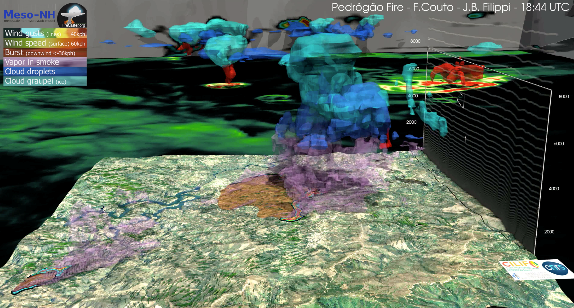
THE ASSOCIATION BETWEEN WILDFIRES AND THE ATMOSPHERE
Extreme wildfires may be associated with strong convective processes due to the heat and moisture released from fires. Such a fire-atmosphere coupling environment leads to the formation of convective clouds: PyroCumulus (PyroCu) and PryroCumulonimbus (PyroCb). The first are more common and can form as relatively small clouds above fire plumes. The second can be observed in plume-dominated wildfires characterized by an intense convection column, above which a cloud resembling towering cumulonimbus may form.
HOW CLOUDS CAN IMPACT FIRE BEHAVIOUR
PyroCb and PyroCu activity can significantly impact fire behaviour through feedback processes between the atmosphere and the fire. In fact, the microphysics process (e.g., the condensation of moisture in the fire plume), can increase fire convection processes by releasing latent heat. As such, those processes can be able to penetrate the atmosphere. This may lead to strong wind variations (direction and speed), convective inflows, and downdraughts. Consequently, PyroCb lightning and an increased fire ignition can trigger and spread new fire outbreaks at a faster rate, enhancing the risk of extreme wildfires. Thus, it becomes extremely important to understand the circumstances and the dynamics between PyroCu, PyroCb, atmosphere, and fire.
tHE EXTREME WILDFIRE EVENT IN PORTUGAL
In 2017, an extreme fire season affected Portugal, resulting in two deadly events. In the first event (June 2017, Pedrógão Grande region) more than 60 lost their life (National CTI Report, 2017). In the second event (mid-October 2017 Portugal Central region), extreme wildfires spread across the mainland resulting in 48 fatalities.
To understand what happened and why the events had such a catastrophic result, the French National Centre for Scientific Research (CNRS), FIRE-RES partner, together with the University of Evora (CILIFO project) made several simulations aiming to obtain the most realistic scenario of the event. The result of this work can be seen here. The simulation can explain PyroCu formation, as well as the wind intensity and turbulence in the convective column over the wildfire. The numerical setup used in this simulation is expected to be deployed for extreme fire events in selected living labs in the FIRE-RES Program work Package 5.